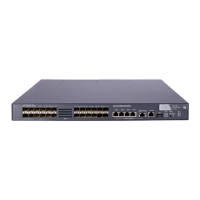212
HP devices can send the three types of DCBX information to a server adapter supporting FCoE, but
cannot receive these types of DCBX information.
DCBX configuration task list
Complete these tasks to configure DCBX:
Task Remarks
Enabling LLDP and DCBX TLV advertising Required
Configuring APP parameters Required
Configuring the 802.1p-to-local priority
mapping
Optional
Configuring ETS parameters
Configuring WRR queuing Optional
Configuring PFC parameters Required
Enabling LLDP and DCBX TLV advertising
To enable the device to advertise APP, ETS, and PFC data through an interface, enable LLDP globally and
enable LLDP and DCBX TLV advertising on the interface.
To enable LLDP and DCBX TLV advertising:
To do… Use the command… Remarks
1. Enter system view
system-view —
2. Enable LLDP globally
lldp enable
Required.
By default, LLDP is globally
enabled.
Enter Layer 2
Ethernet interface
view
interface interface-type interface-
number
3. Enter
Ethernet
interface
view or
port
group
view
Enter port group
view
port-group manual port-group-name
Required.
Use either command.
4. Enable LLDP
lldp enable
Optional.
By default, LLDP is enabled
on an interface.
5. Enable the interface to advertise
DCBX TLVs
lldp tlv-enable dot1-tlv dcbx
Optional.
Disabled by default.
Configuring APP parameters
The device negotiates with the server adapter by using the APP parameters to control the 802.1p priority
values of the protocol packets that the server adapter sends, and to identify traffic based on the 802.1p
priority values. For example, the device can use the APP parameters to negotiate with the server adapter
to set the 802.1p priority of all FCoE (protocol number 0x8906) and FIP (protocol number 0x8914)

